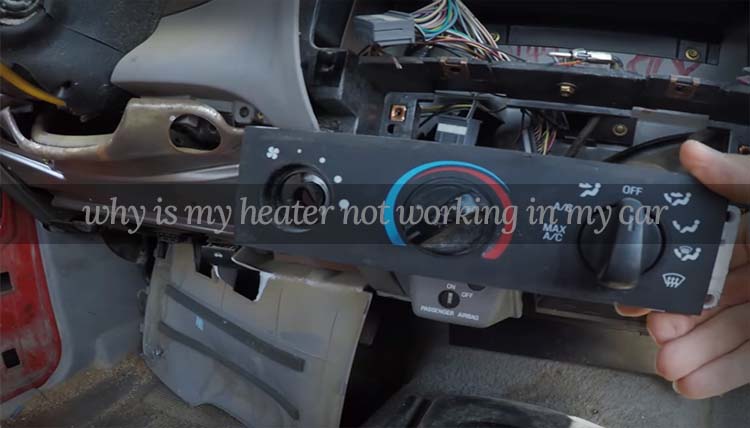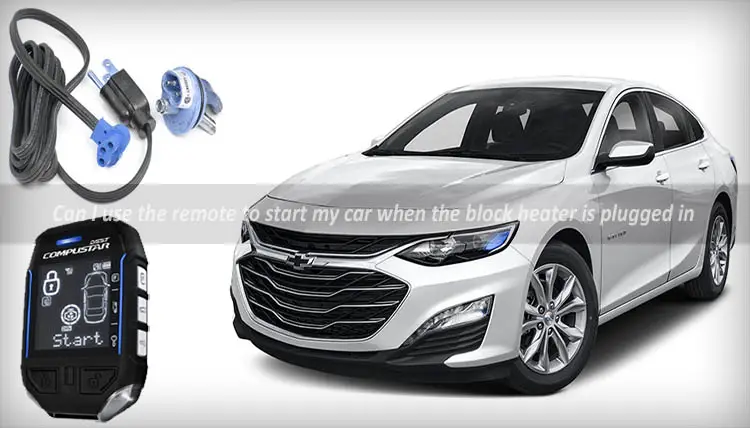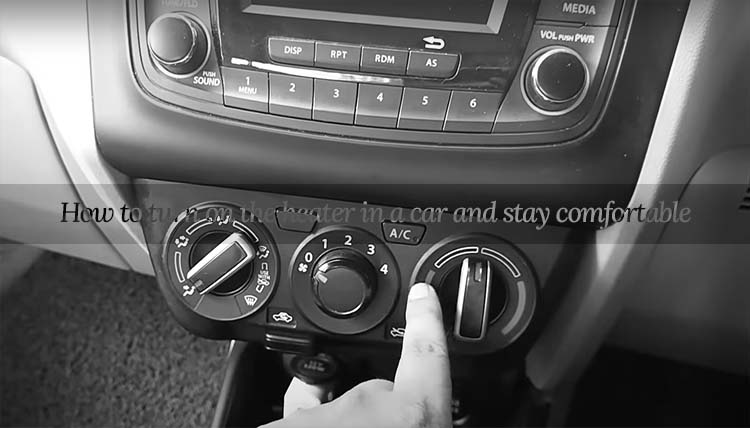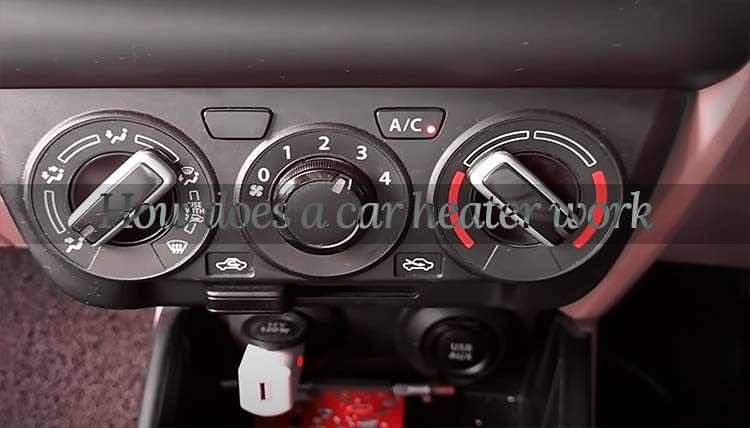Have you ever experienced the frustration of starting your car on a chilly morning only to find that the heater isn’t working? It’s a common problem that can make even the shortest commute uncomfortable and shivering.
A car heater is essential to your vehicle, providing warmth and comfort during cold weather. It is crucial for safe and comfortable driving, particularly in extreme weather conditions.
Various reasons could cause the problem. In this article, we will explore the most common reasons why a car heater may not work and provide solutions to fix the issue.
Whether you’re a seasoned DIYer or a car novice, you’ll find the information you need to get your car’s heater purring like a kitten again.

Why is my heater not working in my car: 4 Reasons with diagnose
Here are four main reasons:
1. Blocked heater core
The heater core is an essential component of a car’s heating system, providing warm air that circulates into the car’s cabin. It looks like a small radiator that is located under the car’s dashboard. As the engine coolant flows through the heater core, the heat from the coolant is transferred to the air that flows over it. This warm air is then blown into the car’s cabin through the vents.
Reasons why a heater core may become blocked
Over time, a heater core can become blocked or clogged with debris, sediment, or other contaminants that accumulate in the coolant. This can cause a restriction in the flow of coolant through the heater core, affecting its ability to transfer heat to the air.
Common causes of a blocked heater core
- Lack of regular coolant system maintenance
- Using the wrong type of coolant or mixing different types
- A dirty or clogged radiator
- Rust and corrosion from old coolant
Signs that a blocked heater core is the issue
If your car’s heater is blowing cold air, even when the engine is warmed up and running, it could be a sign that the heater core is blocked. Other signs to look out for include the following:
- A sweet smell is coming from the vents, which could indicate a coolant leak from a damaged heater core
- Foggy windows, especially when using the defrost setting, could be caused by excess moisture from the cooling system
Solutions for a blocked heater core
If you suspect your heater core is blocked, it’s wise to consult with a professional mechanic who can fix it. Solutions for a blocked heater core include:
- Flushing the cooling system to remove any debris or contaminants
- Chemically cleaning the heater core to break up any blockages
- Replacing the heater core if it is damaged beyond repair
2. Broken thermostat
The thermostat is a component of the car’s engine cooling system that helps regulate engine temperature. It opens and closes to allow coolant to flow through the engine and radiator. The coolant then absorbs heat from the engine and circulates through the heater core to produce warm air for the cabin.
Causes of a malfunctioning thermostat
While thermostats are generally reliable, they can become damaged or broken due to several reasons, such as:
- Corrosion or rust caused by old coolant
- Normal wear and tear over time
- Electrical issues or wiring problems
- An excessive buildup of sludge or other contaminants in the cooling system
Symptoms of a broken thermostat
When a thermostat fails, the engine may overheat, or the cabin may not get enough heat. Some signs of a broken thermostat include:
- Little to no heat in the cabin, even when the engine is warmed up
- The engine temperature gauge shows abnormally low or high readings
- Poor fuel economy or increased fuel consumption
- A sweet, syrupy odor coming from the engine
Solutions for a broken thermostat
The most common solution for a broken thermostat is to replace it with a new one. This involves removing the old thermostat and installing a new one that matches the specifications of your car’s make and model.
3. Blower motor
The blower motor is a crucial component of a car’s heating and air conditioning system. It is responsible for blowing air over the heater core or evaporator, depending on whether the heating or cooling function is selected. The blower motor is typically located under the dashboard on the passenger side of the car.
Reasons why a blower motor malfunction
- Blown a fuse: If the fuse that controls the blower motor is blown, the motor will not work.
- Bad resistor: The blower motor resistor controls the speed of the fan. If the resistor is bad, the fan may only work at certain speeds or may not work at all.
- Worn brushes: The brushes in the blower motor can wear out over time, causing the motor to malfunction.
- Faulty wiring: If there is a problem with the wiring that connects the blower motor to the rest of the electrical system, the motor may not work correctly.
Signs that a malfunctioning blower motor
- No airflow: If the blower motor is not working, you will not feel any air coming from the vents.
- Intermittent airflow: The airflow comes and goes or only works at certain fan speeds.
- Unusual noises: A malfunctioning blower motor makes strange noises, such as squeaking, grinding, or rattling.
Solutions for blower motor issues
- Replace the blower motor: If the motor is damaged beyond repair, it may need to be replaced with a new one.
- Replace the resistor: Sometimes, it can cause of bad resistor, replace it to fix the issue.
- Check and replace fuses: If a blown fuse is an issue, a mechanic may need to replace the fuse.
- Repair wiring: If the wiring is the problem, the mechanic may need to identify the damaged wiring and repair or replace it.
4. Low coolant level
Coolant is vital in a car’s heating system as it helps regulate the engine’s temperature and prevent it from overheating. The coolant circulates through the engine and absorbs heat, which is then transferred to the radiator, where it is cooled down. The warm coolant then flows through the heater core, transferring heat to the air blown into the cabin.
Reasons why coolant levels become low
- Leaks: Coolant can leak from different parts of the cooling system, such as the radiator, hoses, water pump, or engine block. These leaks can be caused by wear and tear, corrosion, or damage to the components.
- Overheating: If the engine overheats, the coolant may boil and evaporate, which can cause the coolant levels to drop.
- Evaporation: Over time, coolant can evaporate, especially if it is not changed regularly or if the system is not sealed correctly.
Signs of low coolant levels
- Heater is blowing cold air: A lack of coolant can prevent the heater core from getting hot, resulting in cold air blowing out of the vents.
- Temperature gauge is higher than usual: Insufficient coolant supply can result in engine overheating, leading to abnormal temperature gauge readings.
- Coolant light is on: Many modern cars have a warning light on the dashboard, illuminating if the coolant levels are low.
Possible solutions for low coolant levels
- Refilling the coolant: If the levels are only slightly low, you can add more coolant to the system. Always use the correct type of coolant and follow the manufacturer’s instructions.
- Fixing leaks: If the coolant levels are consistently low, there can be a leak in the system that needs to be fixed. A mechanic can inspect the system and replace any damaged components.
- Flushing and replacing the coolant: Over time, coolant can become contaminated with rust, dirt, or other debris, which can cause it to lose its effectiveness. Flushing and replacing the coolant at regular intervals can help keep the system running smoothly.
By keeping an eye on your car’s coolant levels and addressing any issues as soon as they arise, you can help prevent low coolant levels and keep your car’s heating system working effectively.
FAQS
Can a fuse cause a car heater not to work?
When the car heater stops working, it could be due to various issues, including a blown fuse. Fuses protect the car’s electrical components and prevent them from damage due to excessive current.
When a fuse blows, the circuit breaks, and the electrical current is cut off. This can result in the heater failing to work. Thus, it’s essential to regularly inspect and replace the car’s fuses to prevent any issues with the heating system.
Why is my car heater not getting hot enough?
Are you feeling the chill in your car, but the heater is not doing its job? There are various reasons for a heater not getting hot enough, including a blocked heater core, a broken thermostat, blower motor issues, or low coolant levels.
However, with regular maintenance and timely diagnosis, you can keep your car’s heating system running smoothly and stay warm during your rides.
Why is my heater blowing cold air in my car?
When winter comes, and your car’s heat starts blowing cold air, it’s a common and frustrating problem. One possible culprit is a blocked heater core due to a lack of coolant system maintenance, using the wrong type of coolant, or a dirty or clogged radiator.
Alternatively, a broken thermostat or malfunctioning blower motor can cause cold air to blow. Don’t wait; take your car to a trusted mechanic to fix the issue.
Conclusion
Finally, a malfunctioning car heater can be a frustrating and uncomfortable issue, especially during the colder months. Whether the problem is a blocked heater core, broken thermostat, malfunctioning blower motor, or low coolant levels, it’s essential to address the issue as soon as possible to avoid further damage and costly repairs.
Regular coolant system maintenance and timely repairs can help keep your car’s heating system running smoothly, providing warmth and comfort during even the coldest days. Don’t let a faulty heater spoil your winter driving experience – take action and get back on the road in comfort and style.
See Also:



